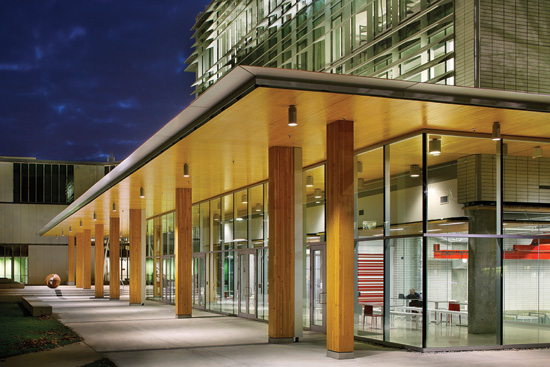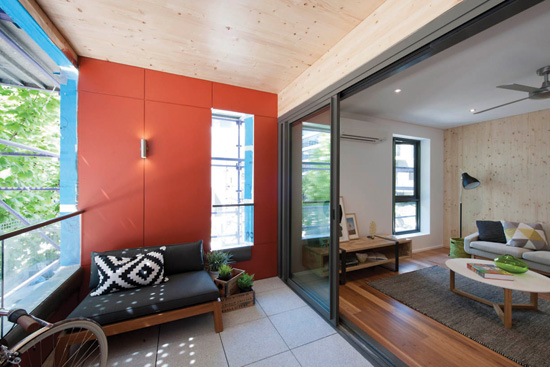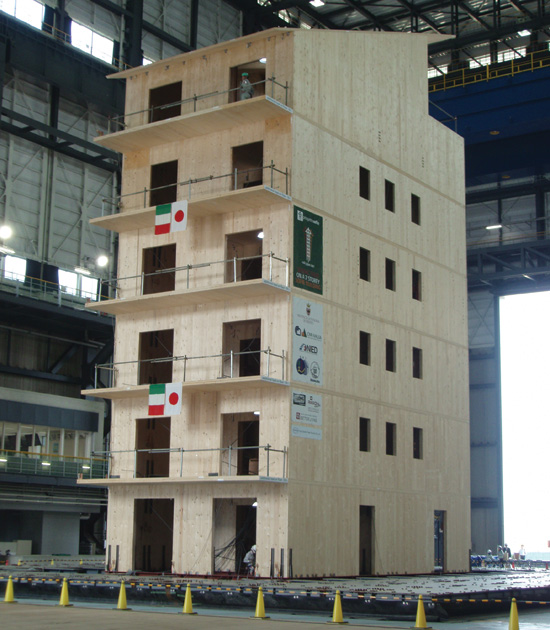Cross Laminated Timber
Three examples of CLT's design flexibility are discussed in case studies later in this course:
• The Crossroads, a 52,000-square-foot client and staff reception area owned by the Promega Corporation, is part of a 300,000-square-foot Good Manufacturing Practices (GMP) facility, which is a highly regulated and specialized building used for manufacturing medical device products. The Crossroads has a fairly complex footprint, forming a sinuous S-curve which wraps around one corner of the larger facility. The design team chose to use wood for the two-story, open area. Structurally, they were challenged to use a material that would perform well for the long-span deck needed to cover the curved roof. CLT provided the solution.
• The Earth Sciences Building (ESB) at the University of British Columbia is comprised of two five-story wings—a laboratory wing made from conventional reinforced concrete and the North Wing, a new LEED Gold building with offices and lecture halls, which utilizes wood as the main structural element. The North Wing features an innovative combination of mass timber systems, including CLT roof and exterior canopies, composite laminated strand lumber/concrete floors, and glued laminated timber (glulam) heavy timber braced frames. The two wings are connected by an atrium, also made from solid wood panel and glulam post-and-beam construction.
• Forté (see image on page 1) is the first CLT building in Australia and currently the world's tallest timber apartment building.4 The walls and floors form a honeycomb-like load-bearing frame, with floor spans reaching up to 19 feet (6 meters) and providing a repetitive load path for vertical and lateral resistance. Lend Lease, which was both the developer and project architect, cites a number of reasons for choosing CLT, including the ability to manufacture materials to precise tolerances off site and fast installation. Installing 10 stories of CLT took five skilled laborers just 10 weeks—which Lend Lease estimates is a 30 percent savings over the same structure in concrete.
 |
Designers of the five-story Earth Sciences Building at the University of British Columbia used CLT for the roof and exterior canopies. Photo courtesy of Martin Tessler, courtesy Perkins+Will |
 |
In addition to its structural characteristics, CLT’s aesthetic benefits are highlighted in Forté suites with exposed balcony ceilings and interior walls. Photo courtesy of Lend Lease |
Cost competitiveness. Light wood-frame construction is still the most economical wood system for low-rise projects. However, CLT is competitive when compared to other materials in a variety of building types. In a 2010 study by FPInnovations, researchers compared the cost of CLT versus certain concrete, masonry and steel building types. Even without accounting for the advantages of faster construction time and lower foundation costs (because of CLT's light weight), CLT was found to be cost competitive for mid-rise residential and non-residential, low-rise educational, low-rise commercial, and one-story industrial buildings.5 CLT is particularly cost effective in large, regularly shaped structures and in situations where fabrication is repetitive.
Manufacturers work closely with the design team to develop estimates based on factors such as the thickness, grade and size of the panels, size of the job (large jobs tend to cost less per square foot as tooling, set-up and delivery costs are distributed), number of openings needed, type of fasteners, and other project-specific factors.
Fire protection. CLT's thick cross-section provides valuable fire resistance because panels char slowly. Once formed, char protects the wood from further degradation. In addition, CLT offers increased compartmentalization if used for interior walls. Fire protection is covered in more detail later in this course.
Seismic performance. Because of their dimensional stability and rigidity, CLT panels create an effective lateral load resisting system. Since it is a system of multiple, small connectors, CLT also offers good ductile behavior and energy dissipation. Researchers have conducted extensive seismic testing on CLT and found panels to perform exceptionally well with no residual deformation, particularly in multi-story applications.
 |
Tested in Japan on the world’s largest shake table, this CLT building survived 14 consecutive seismic events with almost no damage. Photo courtesy of IVALSA |
In Japan, for example, a seven-story CLT building was tested on the world's largest shake table. Even when subjected to severe earthquake simulation (magnitude of 7.2 and acceleration of 0.8 to 1.2 g), the structure showed no residual deformation after the test. The maximum inter-story drift was 1.5 inches and the maximum lateral deformation at the top of the building was just 11.3 inches. The building survived 14 consecutive seismic events with almost no damage—which, in addition to demonstrating the safety of CLT buildings, illustrates their promise in the context of “resilient” design. A growing trend within the sustainability movement, resilient design places an emphasis on making efficient use of resources while creating buildings that last because they are less vulnerable to events such as earthquakes.









